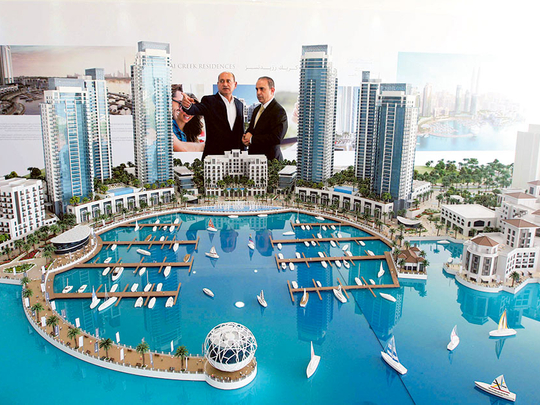
Dubai: Dubai’s next wave of high-rises could be headed for the waterfront, further confirming that the city and its developers retain the appetite for very tall structures.
“There are a number of previously masterplanned zones that are being revised or rejuvenated ... for example, the Dubai Waterfront and at the Lagoons area,” said Simon Townsend, Head of Capital Markets at DTZ, the consultancy. “Also, there are still parcels within Dubailand that are seeing some activity [for high-rises].”
Another potential high-rise location in the making is Dubai Maritime City, where the revised master plan has made ample allocations for them. Omniyat was the first to announce a project there, the Dh600 million “Anwa” residential tower.
Another location in the making is Deira Islands, where Nakheel has just unveiled the blueprint for a 16-tower cluster.
What it means is that there is still plenty of momentum and space that the city’s developers can draw upon for the next high-rise project. Clearly, all of the city’s future towers will not all be packed into areas either side of the Shaikh Zayed Road. (But, in the recent past, Dubai’s developers have by and large opted for spread-out communities with villas, town houses and mid-rise apartments.)
Other global cities are also caught up in the let’s-build-a-skyscraper mindset. And it’s no more about such properties being best equipped to handle a city’s economic and population growth requirements.
“Moving outwards breaks up business clusters and creates political problems, like allowing development on green fields around cities,” states a report issued by Knight Frank on Wednesday. “This moves the pendulum of debate in favour of building upwards to provide more homes and business space.”
Business address
There is also the sheer feel-good factor — companies and their staff prefer to work out of premises that can give them bragging rights. And having their business address in a skyscraper sure gives them those rights.
“For companies today, staff retention is high up the agenda,” the Knight Frank report adds. “Losing star fee-earners is damaging for business, and even the cost of replacing support staff can be higher than the rent paid on their workstations.
“Skyscrapers are one of several means firms have found to make the office an exciting place to be. Also, an inspirational office can encourage staff to interact and share knowledge, thus driving up productivity.”
And investors are working up big appetites for anything that is tall — late last year, London’s eye-catching “Gherkin” Tower was sold to a Brazilian investor, while another landmark in the city, Shard tower, is 95 per cent owned by Qatar’s sovereign fund.
“Global real estate capital markets are seeing more activity from those who wish to deploy money in very large sums [above the $1 billion mark],” the Knight Frank report says. “The size of skyscrapers makes them attractive to such investors, and this will encourage a movement towards developing in scale.”
Tally
London has had 23 new skyscrapers since 2000, while New York City took in four new ones last year alone.
Dubai has had nearly 200 of these in the last 15 years, while Shanghai’s tally is 90.
“Increasingly, mixed-use is moving up the tower agenda — indeed the majority of skyscrapers in both Manhattan and London’s future development pipeline are residential,” the report adds.
“As well as creating a better working environment, skyscrapers can make the city a better place to live. If more homes can be built near to work, commuting times are cut, which benefits social and family lives. When offices and homes are lifted above street level, the ground floors and basements of buildings are freed up for shops and leisure facilities.
“The spaces between tower clusters can be developed as parks and public areas; while skylines are enlivened with iconic architecture.”
Clearly, going tall ticks all the boxes.












